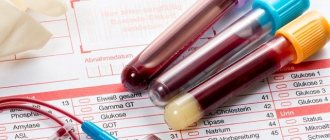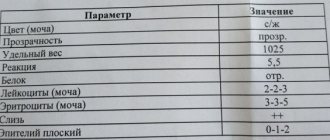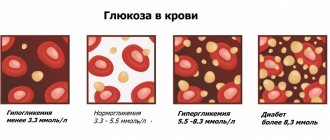Complexes with this research
Fitness control of sports nutrition Assessment of liver function, hormone levels and metabolism when taking sports nutrition 2,950 ₽ Composition
Healthy interest Preventive examination to assess the general condition of the body 2,440 ₽ Composition
Biochemistry of blood. 13 indicators Optimal biochemical blood test RUB 2,260 Composition
IN OTHER COMPLEXES
- Biochemistry of blood. 19 indicators 3,580 ₽
- Diabetes monitoring RUB 1,900
- Preventive check-up RUB 6,870
- Pregnancy planning. Clinical indicators RUB 3,880
- Joining IVF RUB 15,030
What is creatinine
Creatinine is the end product of the breakdown of creatine phosphate, which is involved in the energy metabolism of muscle and other tissues. It is formed in the muscles, then released into the blood, and excreted from the body through the kidneys and urine. Creatinine is a nitrogenous slag, and with increased levels in the blood, it has a toxic effect on organs and systems.
In a healthy person, its concentration in the blood is constant and practically does not change throughout the day. The level of creatinine depends on the rate of formation in the muscles and excretion by the kidneys. When the filtering function of the kidneys is impaired, creatinine in the urine decreases and its level in the blood increases.
Detailed description of the study
The kidneys constantly filter the blood and remove substances formed during metabolism from the body. One of these substances is creatinine.
Creatinine is a metabolite that is formed by the breakdown of the amino acid creatine. It is produced in muscles during their work. By its structure, creatinine is a small molecule, which allows it to be almost completely excreted by the kidneys. Due to constant filtration and excretion, plasma creatinine levels remain relatively constant.
If kidney function is impaired, filtration worsens and the level of creatinine in the blood increases and in the urine decreases. A change in the level of creatinine in the blood plasma may indicate the presence of kidney pathology. These include: acute and chronic glomerulonephritis, pyelonephritis, kidney damage due to diabetes mellitus, arterial hypertension, urolithiasis, amyloidosis.
Changes in creatinine levels may also indicate problems with other organs. Muscle damage, including from trauma or extensive burns, causes an increase in the concentration of creatinine in the blood. A similar situation is observed against the background of starvation and infectious diseases. In this case, the body can use muscle protein as an energy source. With hyperfunction of the thyroid gland, the level of this indicator in the blood also increases.
However, the creatinine level has clinical significance due to the possibility of assessing renal function based on this indicator. Impaired filtration capacity of the kidneys can be asymptomatic for a long time. Therefore, laboratory tests aimed at determining the content of creatinine and urea in the blood are the most important markers of the presence of renal pathology.
The progression of kidney disease is manifested by the following symptoms:
- The appearance of general weakness;
- Problems with urination;
- Decreased appetite and weight;
- Lower back pain;
- Increased blood pressure.
The body's production of creatinine depends primarily on the absolute amount of muscle mass, which is why the normal level of creatinine in children is lower than in adults, and in women it is lower than in men. Also, its level may increase slightly after heavy physical exertion.
Thus, analysis of creatinine levels allows one to suspect renal dysfunction. For a more detailed assessment of the pathology, additional research is necessary on its concentration in daily urine, as well as the content of albumin and urea in the body.
Decreased creatinine levels in the blood
Low creatinine in a child’s blood is a rare occurrence. It can be observed with insufficient body weight and poor or irrational nutrition. In cases of a vegetarian diet in children and adults, this is a characteristic feature that is subject to mandatory correction. Another reason is fasting. If creatinine is low in a child, liver disease may be a possible cause. The indicators are also reduced by the phenomena of hyperhydration (increased water content in the body) and muscle atrophy.
References
- Clinical protocol for diagnosis and treatment of acute renal failure, 2014. - 24 p.
- Kucher, A.G., Kayukov, I.G., Yesayan, A.M. and others. The influence of the quantity and quality of protein in the diet on kidney activity. Nephrology, 2004. - Vol. 8(2). — P. 14‐34.
- KDIGO practice guidelines for the diagnosis, prevention and treatment of mineral and bone disorders in chronic kidney disease (CKD-MBD). Summary of recommendations. Nephrology, 2011. - T. 15(1). — P. 88‐95
- Nephrology. National leadership / ed. ON THE. Mukhina. - M.: GEOTAR-Media, 2009. - 720 p.
What does creatinine show and who is prescribed the test?
The results of determining the level of creatinine in the blood are used to diagnose diseases of the cardiovascular, digestive, endocrine, and nervous systems, the severity of the pathology, and the effectiveness of treatment.
A biochemical blood test for creatinine is prescribed to assess the excretory function of the kidneys.
Signs of impaired filtration and secretion of the kidneys:
- swelling of the face and legs;
- increase in abdominal volume;
- decrease in the volume of urine excreted;
- pain in the lower back, under the ribs along the spine;
- discomfort when urinating;
- dark colored urine with blood clots;
- high blood pressure.
Damage to kidney tissue and intoxication of the body with nitrogenous wastes is indicated by muscle weakness, fatigue, dizziness, loss of appetite, drowsiness, and absent-mindedness.
Determination of creatinine in the blood is a mandatory test before planned and emergency surgery, MRI and CT with contrast, in case of extensive burns and injuries with a large percentage of muscle damage.
A creatinine test is performed for patients with diseases that are accompanied by impaired renal function:
- arterial hypertension,
- renal failure,
- dermatomyositis,
- systemic lupus erythematosus,
- diabetes mellitus,
- jade,
- heart failure,
- glomerulonephritis.
Assessment of the level of creatinine in the blood is included in the complex of screening examinations during pregnancy.
The analysis has no contraindications or restrictions.
Reasons for deviations from the norm
A physiological change in indicators occurs when protein foods predominate in the diet, during periods of stress, and after intense physical activity. The results are also affected by certain medications, pregnancy, and well-developed muscle mass.
High creatinine
A false increase in creatinine levels can be caused by taking certain antibacterial, anti-inflammatory, diuretic drugs, steroid hormones, aspirin, fructose, and glucose.
Causes of pathological increase in creatinine levels:
- renal failure,
- urolithiasis disease,
- diabetes,
- hypertonic disease,
- glomerulonephritis,
- autoimmune diseases;
- leukemia,
- prostatitis,
- atherosclerosis,
- dermatomyositis.
Extensive injuries, burns, inflammation of muscle tissue, dehydration, benign tumors of the thymus gland, and malignant neoplasms increase the creatinine content.
Increased creatinine in the blood occurs during gastrointestinal bleeding, intestinal obstruction, heart failure, myocardial infarction, myocarditis.
In the third trimester, excess of the upper limit of normal occurs due to compression of the kidneys by the fetus and insufficient blood supply to them.
Low creatinine
Diseases associated with impaired synthesis of antidiuretic hormone - muscular dystrophy, anorexia, cachexia, diabetes insipidus - reduce the level of creatinine in the blood. The reasons for insufficient creatinine levels are amputation of limbs, hemodialysis (extrarenal blood purification), and a deficiency of protein products in the diet.
During pregnancy, especially in the first and second trimester, blood volume and glomerular filtration increase, respectively, the amount of creatinine in the blood decreases.
Consequences and complications
If diagnosis is not made in a timely manner and treatment is incorrect, serious complications can occur. The development of the disease leads to a reduction in renal function, disruption of systems and organs, poisoning by metabolic products, and irreversible consequences.
Among the dangerous complications:
- risk of cardiac arrest;
- dysfunction of several body systems;
- blood poisoning;
- uremia.
If there is a pathology, the child is developmentally delayed, does not fit into the team well, and has difficulties in developing speech.
Adrenal insufficiency in children
Adrenal insufficiency in children (AI), or hypocortisolism, is a clinical syndrome caused by a deficiency in the secretion of hormones from the adrenal cortex. Depending on the location of the pathological process, primary, secondary and tertiary NN are distinguished. In primary NN, the adrenal tissue itself is affected; in secondary, it affects the anterior lobe of the pituitary gland with impaired ACTH secretion; the tertiary form is associated with pathology of the hypothalamus and a deficiency in the latter’s production of corticotropin-releasing hormone. NN is divided into acute and chronic. Chronic adrenal insufficiency (CAI) was described in the middle of the 19th century. Addison based on the autopsy results. This form occurs with a frequency of 1 case per 10 thousand people, 2 times more often in mature and elderly males. Many authors note that CHN in children is rarely diagnosed due to the diversity and nonspecificity of the symptoms of hypocortisolism.
Clinical symptoms of chronic adrenal insufficiency occur when 95% of the adrenal cortex tissue is affected. In almost 60% of patients, adrenal insufficiency occurs as a result of idiopathic adrenal atrophy.
In this group, the main cause of the development of the disease is currently considered to be autoimmune destruction of the adrenal cortex (autoimmune adrenalitis 70–85%).
In the tissue of the affected adrenal glands in this form of pathology, extensive lymphoplasmacytic infiltration is noted, the adrenal glands are reduced in size, and the cortex is atrophied. In the blood serum of such patients, antibodies to microsomal and mitochondrial antigens of the adrenal cortex, as well as antibodies to 21-hydroxylase, one of the key enzymes of steroidogenesis, are detected.
Autoimmune adrenalitis is often combined with other autoimmune endocrinopathies. Autoimmune polyglandular syndrome type 1 (APS-1) includes adrenal insufficiency, hypoparathyroidism and candidiasis. In some patients, this syndrome is combined with hypogonadism, alopecia, vitiligo, pernicious anemia, autoimmune thyroid diseases, and chronic hepatitis.
Autoimmune polyglandular syndrome type 2 (APS-2) is characterized by a combination of type 1 diabetes mellitus, autoimmune thyroid disease and adrenal insufficiency (Schmidt syndrome). APS-1 is inherited in an autosomal recessive manner, and APS-2 is inherited in an autosomal dominant manner. A genetic predisposition to autoimmune adrenal insufficiency is evidenced by the discovery in most patients of an association with the genes of the HLADR3, DR4 and HLAB8 system. In these patients, there is a decrease in the suppressor activity of T lymphocytes. Family forms of this lesion are described. Destruction of the adrenal cortex is possible as a result of its damage due to tuberculosis, disseminated fungal infection, toxoplasmosis, and cytomegaly. The occurrence of congenital hyperplasia is observed after severe viral infections (ARVI, measles, etc.); less commonly, the causes of its development are adrenoleukodystrophy, tumor processes, and congenital fatty adrenal hyperplasia. Sometimes XNN develops against the background of calcification of the adrenal glands, which is a consequence of any of the above processes. In other cases, petrification in the adrenal glands is discovered by chance, during an X-ray examination - long before the onset of clinical symptoms of XUI.
Much less common are secondary and tertiary CNN, in which atrophy of the adrenal cortex is a consequence of insufficient production of ACTH by the pituitary gland, or by the hypothalamus - corticoliberin. A decrease in the secretion of these hormones can be observed in various pathological processes of the hypothalamic-pituitary region: tumors, vascular disorders, trauma, infection, intrauterine damage to the pituitary gland. A decrease in ACTH production can be observed with various organic lesions of the central nervous system, long-term use of glucocorticoids, and tumor damage to the adrenal cortex.
The main clinical symptoms of XHH are associated with insufficient secretion of corticosteroids and aldosterone. Clinical symptoms in XHH usually develop slowly, gradually - patients cannot determine when the disease began. However, in the case of congenital adrenal hypoplasia, symptoms of the disease may appear soon after birth and are associated with salt loss. Such children are lethargic, do not gain weight well (weight loss after birth exceeds the physiological norm by 300–500 g), spit up, urinate copiously and frequently at first, tissue turgor is reduced, and enjoy drinking salted water. In such cases, you should pay attention to darkening of the skin, and less often, of the mucous membranes. Often, dyspeptic disorders and intercurrent diseases provoke crises of acute adrenal insufficiency.
In older children, the main symptoms of chronic adrenal insufficiency are weakness, fatigue, adynamia, especially at the end of the day. These symptoms disappear after a night's rest, but can occur periodically due to intercurrent diseases, surgical interventions, and mental stress. In the pathogenesis of this syndrome, the main importance is attached to disorders of carbohydrate and mineral metabolism.
Along with general weakness, loss of appetite, loss of body weight, perversion of taste (they eat salt by the handful), especially in the afternoon, are noted. Patients often complain of nausea, sometimes vomiting, abdominal pain, and decreased secretion of pepsin and hydrochloric acid. Changes in stool are accompanied by diarrhea and constipation. Other children have thirst and polyuria. Vomiting and diarrhea lead to even greater sodium loss and accelerate the development of acute adrenal insufficiency. One of the early symptoms of Addison's disease is arterial hypotension: both systolic and diastolic blood pressure decreases. This is due to a decrease in circulating blood volume, as well as glucocorticoids, which are important for maintaining vascular tone. The pulse is soft, small, slow.
Patients often experience orthostatic hypotension, which is associated with dizziness and fainting. However, it should be borne in mind that blood pressure during adrenal insufficiency in patients with hypertension may be normal. The size of the heart decreases, shortness of breath, palpitations, and irregular heart rhythm may be observed. Changes in the ECG are caused by intracellular hyperkalemia and manifest themselves in the form of ventricular extrasystole, flattened biphasic T wave, prolongation of the PQ interval and QRS complex.
Hypoglycemic conditions that appear on an empty stomach or 2-3 hours after a meal are typical for adrenal insufficiency and are associated with glucocorticoid deficiency and a decrease in glycogen reserves in the liver. Hypoglycemic attacks are mild and are accompanied by a feeling of hunger, sweating, pallor, and tremor of the fingers. Neurohypoglycemic syndrome is characterized by apathy, mistrust, depression, a feeling of fear, and convulsions are possible.
Changes in the function of the central nervous system are manifested in memory loss, rapid emotional fatigue, absent-mindedness, and sleep disorders. Adrenal insufficiency accompanies adrenoleukodystrophy. This is a genetic, X-linked recessive disease that affects the white matter of the nervous system and the adrenal cortex. Demyelination progresses rapidly, manifested by generalized ataxia and seizures. Neurological symptoms are preceded by clinical signs of adrenal insufficiency.
Pigmentation of the skin and mucous membranes is observed in almost all patients and can be expressed long before the appearance of other symptoms of XHH. Generalized pigmentation is caused by excessive secretion of ACTH and β-melanocyte-stimulating hormone. Children's skin often has a golden brown color, less often a light brown or bronze tint. The most intense pigmentation is expressed in the area of the nipples of the mammary glands, scrotum and penis in boys, the white line of the abdomen, in places where the skin rubs with clothing, scars, knee, elbow joints, small joints of the hands, and gum mucosa. Sometimes the first indication of the presence of the disease is a long-lasting tan. Pigmentation intensifies during the period of increasing adrenal insufficiency. In 15% of patients, pigmentation can be combined with areas of depigmentation. A non-pigmented form of the disease, which is characteristic of secondary XHH, is rare.
With early onset of the disease, children lag behind in physical and sexual development. Often, XHH in children is mild and is diagnosed in the event of the addition of intercurrent diseases.
In the typical course of XHH, an increase in the number of eosinophils, relative lymphocytosis, and moderate anemia are detected in the blood. A characteristic biochemical sign of the disease is an increase in the blood serum levels of potassium, creatinine, urea, while reducing the content of sodium and chlorides. Hypercalcemia is combined with polyuria, nocturia, hypoisosthenuria, hypercalciuria. The diagnosis is confirmed by a low level of cortisol in the blood (less than 170 nmol/l) taken in the morning. To determine the erased forms of hypocortisolism and differential diagnosis, it is recommended to conduct stress tests with synacthen. Synthetic ACTH stimulates the adrenal cortex and reveals the presence of reserves. After determining the level of cortisol in the blood plasma, synacthen is injected intramuscularly and after half an hour the cortisol concentration is examined again. Samples are considered positive if the cortisol level doubles. The study can be carried out against the background of prednisolone replacement therapy. This test also allows you to differentiate between primary and secondary HH.
Direct confirmation of the presence of primary adrenal insufficiency is a sharp increase in the level of ACTH in the blood plasma; in case of secondary adrenal insufficiency, its decrease. To diagnose hypoaldosteronism, the content of aldosterone and renin in the blood plasma is determined. In primary adrenal insufficiency, aldosterone levels are reduced or at the lower limit of normal, and renin levels increase. Imaging of the adrenal glands (ultrasound, computed tomography) also allows us to clarify the form of adrenal insufficiency.
The differential diagnosis of Addison's disease must be carried out with a number of diseases occurring with weight loss, hypotension, polyuria, anorexia: intestinal infections, intoxications of other etiologies, helminthic infestation, chronic pyelonephritis, diabetes insipidus, with a salt-wasting form of adrenal cortex dysfunction, with hypoaldosteronism. The diagnosis of XHH is facilitated by the presence of skin pigmentation, although it may be absent in secondary XHH. It is necessary to take into account that, subject to timely diagnosis and properly selected replacement therapy, chronic adrenal insufficiency has a favorable prognosis.
Some patients are admitted with an erroneous diagnosis: asthenia, vegetative-vascular dystonia, malnutrition of unknown etiology, helminthic infestation, gastritis, etc.
Diagnostic errors during the XHH crisis are associated with underestimation of the main symptoms of the disease. Incorrect diagnoses include acute appendicitis, gastritis, cholecystitis, brain tumor, encephalitis, and acetonemic vomiting.
Addisonian crisis, an acute adrenal insufficiency (AIF) that develops as a result of a rapid decrease in the production of adrenal hormones, should be recognized as life-threatening for patients with XHH. This condition can develop after many years of subclinical course of XHH, or the appearance of AHF is preceded by an acute infection or another stressful situation (trauma, surgery). Weakness and hyperpigmentation of the skin and mucous membranes increase, appetite progressively worsens until aversion to food. Nausea turns into vomiting; as the crisis progresses, it becomes uncontrollable, and loose stools appear. Some patients experience severe abdominal pain. The leading clinical symptoms of acute insufficiency are usually: deep decrease in blood pressure, weak pulse, muffled heart sounds, pale mucous membranes, peripheral acrocyanosis, profuse sweat, cold extremities, hypothermia. Electrolyte disturbances, hypoglycemia, and hyperazotemia increase. Hyperkalemia has a toxic effect on the myocardium and can lead to cardiac arrest.
The main principle of replacement therapy for XHH and Addisonian crisis is the combined use of glucocorticoids and mineralocorticoids, which support vital functions: ensure the body’s adaptation to environmental stress and maintain water-salt balance. Preference is given to hydrocortisone, prednisolone, fludrocortisone. Hydrocortisone has both glucocorticoid and mineralocorticoid effects.
Monotherapy with mineralocorticoids or glucocorticoids is performed in a small percentage of cases. Currently, effective and easy-to-use tablet preparations of hydrocortisone and fludrocortisone are widely used in clinical practice.
Most patients with XHH require ongoing glucocorticoid replacement therapy, most often hydrocortisone and prednisolone are used for this purpose. Preference is given to hydrocortisone, which has both glucocorticoid and mineralocorticoid effects. Glucocorticosteroid replacement therapy should mimic the physiological secretion of these hormones. According to the circadian rhythm of glucocorticoids, hydrocortisone or prednisolone should be prescribed in the morning for mild cases, and in the morning and afternoon for moderate cases.
With constant replacement therapy for XHH, the dose of hydrocortisone in young children should be approximately 1–3 mg, and in older patients - up to 15 mg and 7.5 mg, respectively.
It should be remembered that the level of glucocorticoid secretion normally depends on the functional state of the body. In case of injuries, acute infections, physical or mental stress, the daily dose of glucocorticoids should be increased by 2–3 times. Before minor interventions (gastroduodenoscopy, anesthesia, tooth extraction, etc.), the patient needs a single parenteral administration of hydrocortisone 12.5–25–50 mg 30 minutes before the procedure. During planned operations, it is recommended to begin increasing the dose of glucocorticoids on the eve of the intervention and administer them only parenterally. Hydrocortisone is administered intramuscularly at 12.5–25–50 mg 2–4 times a day. On the day of surgery, the dose of the drug is increased 2–3 times, with part of the medicine administered intravenously, and the rest intramuscularly every 4–6 hours for 1–2 s. In the following days, they gradually switch to replacement therapy.
The criteria for the adequacy of glucocorticoid therapy are the maintenance of normal body weight, the absence of complaints of a constant feeling of hunger and signs of hormone overdose, skin hyperpigmentation, and normal blood pressure.
If the use of glucocorticoids does not normalize blood pressure, there is no weight gain, and hyponatremia persists, it is necessary to prescribe mineralocorticoids. Combination therapy with gluco- and mineralocorticoids is usually necessary for most patients with severe XHH.
The daily dose of fludrocortisone is selected individually. The need for this hormone may occur daily or once every 2-3 days. In infants in the first months of life, the need for fludrocortisone per kilogram of body weight is higher.
The adequacy of the dose of mineralocorticoids is indicated by normal levels of plasma potassium and sodium, and plasma renin activity.
In case of an overdose of mineralocorticoids, peripheral edema, cerebral edema, and cardiac arrhythmias due to water retention may develop. To eliminate these complications, it is necessary to discontinue mineralocorticoids, increase the dose of glucocorticoids by 1.5–2 times, limit the content of table salt in food, prescribe juices, 10% potassium chloride solution.
Emergency measures are required when Addisonian crisis develops. The greatest danger to life occurs in the first day of acute hypocortisolism. The primary objectives are the administration of a sufficient amount of corticosteroids or its synthetic analogues, the fight against dehydration, and the correction of electrolyte disturbances.
When administering parenteral corticosteroids, hydrocortisone is preferred, while prednisolone and dexamethasone should be used only as a last resort.
Hydrocortisone is administered intravenously along with glucose over 4-6 hours. On the first day, the dose of hydrocortisone is 10-15 mg/kg, prednisolone - 5 mg/kg. In the next day, the dose of intravenously administered drugs is reduced by 2–3 times. At the same time, hydrocortisone is administered intramuscularly after 4–6 hours, 25–75 mg/day.
Along with the administration of glucocorticoids, therapeutic measures are carried out to combat dehydration and shock. The amount of isotonic sodium chloride solution and 5–10% glucose solution is approximately 10% of body weight, half the daily volume of liquid is administered in the first 6–8 hours. For repeated vomiting, intravenous administration of 5–10 ml of 10% sodium chloride solution is recommended. Add 5–10 ml of ascorbic acid to the dropper.
When the patient's condition improves, the intravenous administration of hydrocortisone is completed, continuing its intramuscular administration 4 times a day, 25–50 mg per dose. Then gradually reduce the dose of hydrocortisone and lengthen the interval between injections. After stabilization of the disease, the patient can be transferred to tablet hydrocortisone.
In some patients, it becomes necessary to combine the administration of hydrocortisone and, when using prednisolone, it is necessary to prescribe the drug DOXA, which is administered 1–2 ml per day intramuscularly. After vomiting stops, fludrocortisone tablets 0.1 mg/day are used instead of DOX injection. Timely diagnosis of XHH and properly selected replacement therapy, which is carried out for life, are the key to preventing Addisonian crisis: under these conditions, children, as a rule, develop normally.
V. V. Smirnov, Doctor of Medical Sciences, Professor I. S. Mavricheva, Candidate of Medical Sciences, Russian State Medical University, Moscow
Interpretation of results
Reference values are determined by age, gender, muscle mass and body type. In women and asthenics, the concentration of creatinine in the blood is lower than in men and hypersthenics.
In healthy women over 20 years of age, the normal concentration of creatinine in the blood is 50-98 micromol/l, in men - 64-111 micromol/l. With age after 60 years, the amount of creatinine increases slightly, and is several micromoles above the upper limit of normal.
Children have lower creatinine concentrations:
- from birth to one year - 15–37 µmol/l;
- from one to 5 years – 21–42 µmol/l;
- from 5 to 10 years - 28–65 µmol/l;
- from 10 to 15 years - 34–77 µmol/l;
- from 15 to 20 years - 51–92 µmol/l.
For physiological reasons, the creatinine content in the blood is slightly higher or lower than normal. The stronger the deviation, the more severe the pathological process.







